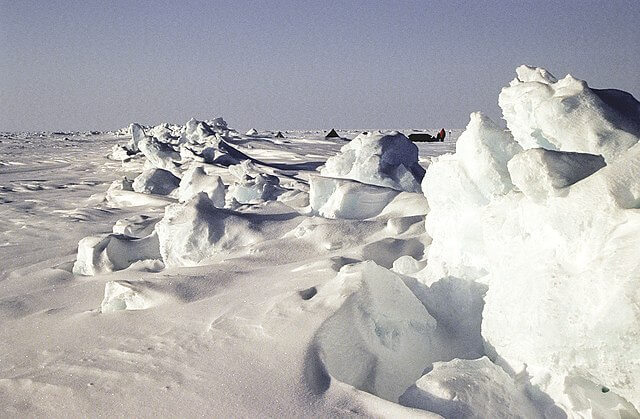
Wildlife are at risk from alarming levels of PFAS in Norwegian Arctic ice.
A study led by Oxford University found 26 different types of PFAS compounds in the ice around Svalbard, posing a threat to ecosystems downstream.
New research reveals that the toxic PFAS found in Norwegian Arctic ice may be a significant environmental stressor for the wildlife in the region.
The Oxford University-led study found that when the ice around Svalbard, Norway, melted, 26 different types of PFAS compounds could move from glaciers into ecosystems like Arctic fjords and tundra.
The meltwater may contain a mix of contaminants, including PFAS, that affect the entire food web, including plankton, fish, seals, and apex animals like polar bears, whose blood PFAS levels have previously been found to be high.
“There’s a washout of contaminants that occurs seasonally … and some PFAS seem to be mobile during melts, which could be important to ecosystems downstream,” said Dr William Hartz, a lead author on the study who noted a “doubling up effect” on animals as climate changes and ice melts. The climate has been warming faster in Svalbard than the world’s average.
“As a polar bear, you have exposure to toxic manmade chemicals, and stresses from a changing habitat,” he added.
The roughly 12,000 chemicals that make thousands of consumer goods resistant to heat, water, and stains are known as PFAS. They have been linked to cancer, liver disease, kidney stress, fetal complications, and other serious health issues, which is why they are referred to as “forever chemicals.”
PFOS and PFOA, two of the most dangerous PFAS compounds, were among those that researchers discovered in ice at concentrations that were higher than the US advisory drinking water limits.
Additionally, the study found particularly high levels of TFA, a byproduct of refrigeration. Numerous nations agreed to phase out chlorofluorocarbons, or CFCs, a powerful greenhouse gas used for refrigeration, during the 1987 Montreal Protocol. Hydrofluoro-olefins, or HFOs, eventually took their place.
According to the study and the findings of previous measurements, HFOs, which are also greenhouse gases, can transform into TFA once they enter the environment. TFA levels are rising in the Arctic. TFA and other PFAS compounds are highly mobile and can travel through the atmosphere to settle in the Arctic or other parts of the world.
Despite being thought to be less harmful than many other PFAS, TFA has not been thoroughly researched, so no one knows what harm the compounds might cause.
“Limited knowledge about the safe levels of TFA in the environment needs addressing,” the authors stated.
——————————————————————————
At Natural World Fund, we are passionate about stopping the decline in our wildlife.
The declines in our wildlife is shocking and frightening. Without much more support, many of the animals we know and love will continue in their declines towards extinction.
When you help to restore a patch of degraded land through rewilding to forests, meadows, or wetlands, you have a massive impact on the biodiversity at a local level. You give animals a home and food that they otherwise would not have had, and it has a positive snowball effect for the food chain.
We are convinced that this is much better for the UK than growing lots of fast-growing coniferous trees, solely to remove carbon, that don’t actually help our animals to thrive.
This is why we stand for restoring nature in the UK through responsible rewilding. For us, it is the right thing to do. Let’s do what’s right for nature!
Support our work today at https://naturalworldfund.com/ and join in the solution!

